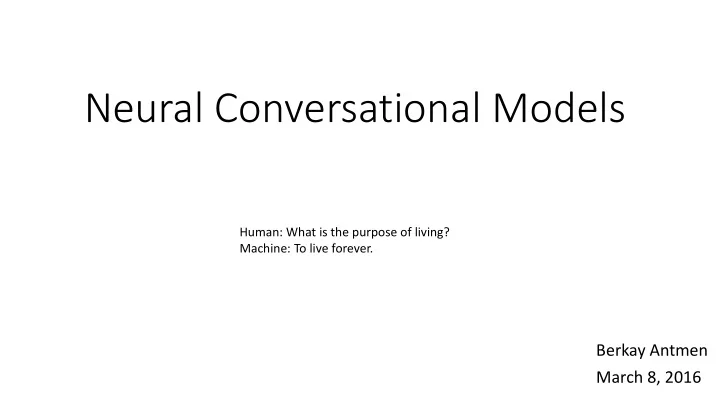

Neural Conversational Models Human: What is the purpose of living? Machine: To live forever. Berkay Antmen March 8, 2016
Conversational model • Purpose: Given previous sentences of the dialogue and context, output a response
• Why? • How? • goal driven dialogue systems • discriminative • generative • e.g. tech support • non-goal driven dialogue systems • heavily hand-crafted • data-driven systems • e.g. language learning, video game characters
Demo (Cleverbot) • http://www.cleverbot.com/ • http://www.cleverbot.com/conv/201603150055/VWU01366204_Hi-can-you- help-me (Troubleshooting) • http://www.cleverbot.com/conv/201603150111/VWU01366307_Hello (Basic) • http://www.cleverbot.com/conv/201603150120/VWU01366357_What-is-the- purpose-of-life (Philosophical) • http://www.cleverbot.com/conv/201603150204/VWU01366635_We-are-no- strangers-to-love (extra)
Frameworks • sequence-to-sequence (seq2seq) • classification problem over a known vocabulary • input: sequence of tokens • output: sequence of tokens image: Sutskever et. al. 2015
Frameworks: seq2seq • The goal: estimate • problem: boundaries • solution: • training: maximize (target given source) • inference: • approximated by beam search equation images: Sutskever et. al. 2015
Beam Search w=3 image: http://bit.ly/251bIfl
A Neural Conversational Model • IT helpdesk dataset of conversations (closed-domain) • OpenSubtitles movie transcript dataset (open-domain) • Experiments: troubleshooting, general knowledge, philosophical etc.
A Neural Conversational Model • training: maximize cross entropy of the correct sequence given its context • (aside) how is cross entropy measured when the true distribution of the words in the corpus is not known? Monte Carlo estimation: training set is treated as samples from the true distribution • inference: greedy search image: Chris Olah
Some results (troubleshooting) Password issues Browser issues Cleverbot: http://www.cleverbot.com/conv/201603150055/VWU0136620 4_Hi-can-you-help-me
Some more results Basic Contexts and multiple choice Cleverbot: http://www.cleverbot.com/conv/201603150111/VWU01366307_Hello
Some more results Philosophical Opinions Cleverbot: http://www.cleverbot.com/conv/201603150120/VWU0136635 7_What-is-the-purpose-of-life
Evaluation • Perplexity measures how well a model predicts the given samples • 2 𝐼 𝑟 (𝑇 1 ,…𝑇 𝑜 ) = 2 − 𝑗 𝑟 𝑇 𝑗 log 2 𝑟(𝑇 𝑗 ) Experiment Model Perplexity IT Helpdesk Troubleshooting N-grams 18 IT Helpdesk Troubleshooting Neural conversational model 8 OpenSubtitles N-grams 28 OpenSubtitles Neural conversational model 17
Evaluation • human evaluation against a rule-based bot (CleverBot) • asked a list of questions to both models • judges picked the bot they preferred • Mechanical Turk # questions # judges # prefer neural # prefer # tie # disagreement model CleverBot 200 4 97 60 20 23
Wrong objective function? • the answers are not diverse, i.e. likely to give most probable answers without giving out much information • e.g. S=“How old are you?” T=“I don’t know.” • 𝑞(𝑈|𝑇) high, 𝑞(𝑇|𝑈) low • e.g. S=“How old are you?” T=“I am 10 years old” • 𝑞(𝑈|𝑇) lower, 𝑞(𝑇|𝑈) higher • not really obvious from the selected examples in the paper
A Diversity-Promoting Objective Function for Neural Conversation Models Li et. al. 2015
A Diversity-Promoting Objective Function for Neural Conversation Models • An alternative objective function: Maximum Mutual Information (MMI) • maximize mutual information between source (S) and target (T) • 𝐽 𝑇, 𝑈 = log( 𝑞(𝑇,𝑈) 𝑞 𝑇 𝑞(𝑈) ) • 𝑈 = arg 𝑈 max 𝑚𝑝𝑞 𝑈 𝑇 − 𝜇𝑚𝑝𝑞(𝑈) • remember, previously
Some results (OpenSubtitles)
Some results (Twitter)
Frameworks • Hierarchical Recurrent Encoder Decoder (HRED) image: Serban et. al. 2015
Frameworks: HRED • Motivation?
Hierarchical Neural Network Generative Models for Movie Dialogues • Non-goal driven: can be easily adapted to specific tasks • Bootstrapping • from word embeddings OR • from a large non-dialogue corpus (Q-A SubTle containing 5.5 pairs) • Interactive dialogue structure • end-of-utterance token • continued-utterance token
Dataset • why movie scripts? • large dataset • wide range of topics • long dialogues with few participants • relatively few spelling mistakes and acronyms • similar to human spoken conversations • mostly single dialogue thread • atomic entries are triples • 13M words total; 10M in training
Evaluations (movie dialogue generation) • test set perplexity and classification errors when bootstrapping from SubTle corpus
Evaluations
Future work? • study larger length dialogues (as opposed to triplets) • bootstrapping on other non-dialogue but large datasets
Thank you! Questions?
References • seq2seq http://arxiv.org/abs/1409.3215 • neural conversational http://arxiv.org/abs/1506.05869 • hierarchical http://arxiv.org/abs/1507.02221 • hierarchical conversational http://arxiv.org/abs/1507.04808 • MMI http://arxiv.org/abs/1510.03055
Recommend
More recommend